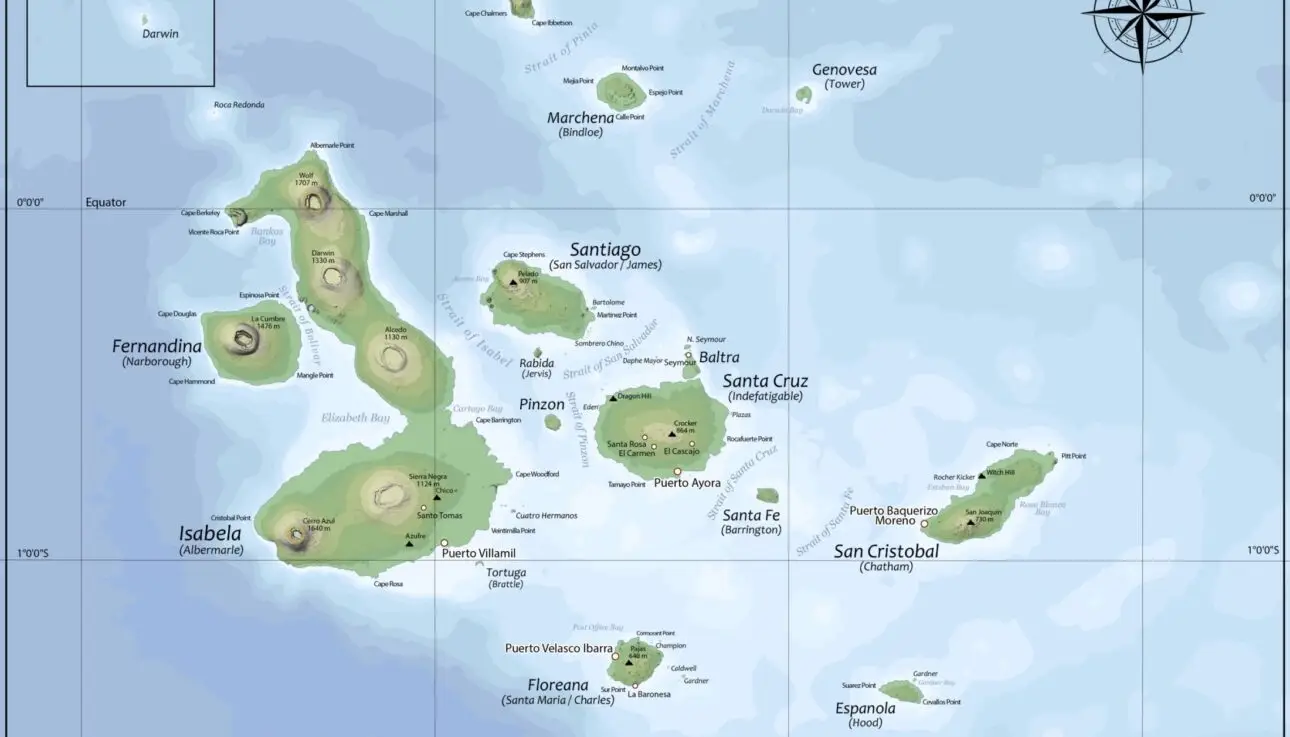Questions and Answers for those planning a trip to the Galapagos.
After selling Galapagos trips for many years the main question I ask first is about time – do you have time to do all the islands or just part of them? A week is enough to do roughly half of the main islands.
You’ll start on Santa Cruz Island, flying over from Ecuador (Quito or Guayquil) and join your vessel early afternoon. Bearing in mind that this flight takes 2.5 – 3 hours and there are park fees to pay too, a trip to the Galapagos is not a budget option, and to make the trip worthwhile I would not usually suggest anything less than 7 nights here.
A 6 to 8-night voyage will usually either focus on the central and western islands (western circuit), or the central, southern and northern islands (eastern circuit) .
Highlights include Fernandina and Isabela in the ‘western circuit’ and Tower and Hood Islands in the ‘eastern circuit’.
All circuits visit the main central islands of Santa Cruz and Santiago.
Shorter 3 or 4 night trips concentrate on the main sites in the central islands and will give you a ‘taster’ but remember that to get there and back from Ecuador takes a day so your ratio of travel to days out sightseeing won’t be great!
The Galapagos islands are located in the Pacific Ocean, roughly 1000km off the coast of Ecuador, straddling the equator. Roughly a 2 to 3 hour flight from Quito or Guayaquil.
The islands’ isolation and creation at different times through their volcanic ‘birth’ has permitted life forms to evolve into species found only in Galapagos. The archipelago encompasses over 50 islands of volcanic origin that are spread out over an area of about 4500 sq. km. The oldest of these is not more than 2.4 million years old, a baby in geological terms. The islands creation is due to their being among the most volcanically active group of islands in the world.
The Galapagos gained fame with the publication of Darwin’s Voyage Of The Beagle and Origin Of The Species, but also with various scientific expeditions, notably, The California Academy of Sciences in 1906.
The Galapagos National Park was established in 1959 to protect the unique and therefore precious flora and fauna of the islands. In that same year the Charles Darwin Research Station was founded in Academy Bay on Isla Santa Cruz. Both of these helped to create the well-managed and protected national park you can see today.
You don’t need to spend a couple of weeks on a voyage around the Galapagos Islands but it is recommended for those with an interest in natural history and evolution since the different ages of the islands are the reason for Darwin’s realising that the creatures on each island had evolved differently.
The habitats of the newer western islands are vastly different from the older eastern islands. From a scientific point of view, this is fascinating to experience.
However, if you are happy to just view a selection of Galapagos key species with no particular interest in evolution or a particular species then you will get plenty of joy out of a shorter voyage. You’ll still see wonderful island scenery and beaches, giant tortoises, iguanas, boobies, sea lions and plenty of other wildlife and birds besides. Not to mention opportunities for snorkeling and diving.
It is possible to do a land based tour where you island hop between islands from your main base in a lodge in Santa Cruz, but unless you are unable to travel by sea it’s not recommended as you’ll miss out on a lot. Also some sort of boat journey will be needed to many of the sites, even those closer to Santa Cruz and the central islands.
Even if you don’t get on well with boats, it is worth remembering that mostly the boats travel by night to the next destination, and when you are lying down the symptoms of sea-sickness are mitigated. During the day you will be doing island ‘landings’ to significant wildlife areas. See below for more information about land-based trips to the Galapagos.
No you don’t need to go on a cruise, although if you are scientifically minded you should really consider it. Although you can’t visit all the uninhabited islands on a land based tour you can still have a fabulous Galapagos experience.
From a base on central Santa Cruz you can see giant tortoise and visit the uninhabited islands of North Seymour, Bartolome, South Plazas and Santa Fe. You can get away from the more populated central island with a chance to snorkel and swim with dolphins.
If you have longer to stay then you can also stay on the Islands of Isabela and San Cristobal. On Isabella you can view flamingo lagoons, tortoise, and snorkel and hike to the second largest volcanic crater in the world. You’ll see marine iguanas sea birds, reef fish, sealions and many other marine species on a snorkeling adventure.
On San Cristobal you can view the interpretive centre to learn about conservation and how the islands are being protected and on boat trips snorkel and view boobies and frigate birds, along with sea lions and turtles. You can also explore the highland areas of the island on hikes and mountain bikes and take a full day tour to Espanola Island and Punta Suarez islands – famous for the nesting Waved Albatross (April to December), and plenty of other bird and marine species.
For more about land based trips see our 12 Day Complete Galapagos Itinerary here. This can be shortened for those who have less time.
There’s not really a ‘best’ time. It may depend on the wildlife you want to see. The waved albatross, for example, can only be observed between April and November.
There are two main seasons: cool and dry (June to November), and warm and wet (December to May).
August and September see the coolest temperatures and choppiest conditions, but many cruises still operate at this time as it is peak holiday season.
Don’t be put off by the term ‘warm wet season’, as these are sunnier months with clearer skies, and calmer, clearer seas. There are usually just short periods of drizzle.
Wildlife is plentiful year round with all the ‘key’ species present.
For snorkeling and diving the warmer season is better as it’s calmer with better visibility. There are also more sea turtles around.
Note that for diving you’d need to join a proper dive live-aboard with all that entails, or perhaps add on in a resort which offers diving.
Most other vessels only offer snorkeling and this is enough for most people due to the shallow clear waters.
Jan – Feb – wettest season, but often clear skies too. Land birds courtship rituals, marine iguanas are brightly coloured.
March and May – as the rains start to stop is a good time to visit – flowers, and young animals and birds hatching.
June – July – cooler as Humboldt current arrives. As dry season progresses – cloudier skies, more wind, cooler waters, more waves – visibility in the water not as good for diving/snorkeling. Wildlife, as always is still prolific though. Mating rituals. July highlight is the mating ritual of the blue footed booby! Waved albatross start to arrive on eastern most islands.
August & September – winds and waves. Lots of visitors from US and Europe due to school holidays. Avoid travelling now unless you have no other choice.
October – Nov – winds start to ease up. Getting warmer. Quite a good time to visit as less visitors.
December – warm weather begins in earnest. Lots of wildlife and greener islands. Avoid Xmas Hols though.
To summarise, late November, early Dec and March to May are good times to visit, warmer with clear skies and not too wet or busy. For diving and snorkeling then the warm season is better as better visibility. If you’re not keen on a specific wildlife ‘event’, then there is always plenty of unique wildlife to experience no matter what time of year.
Wi-fi may be sporadic at times. And it depends on the vessel. However most boats are now able to offer satellite connection wi-fi.
We have some superb local agents who we’ve been working with for many years.
In addition, all your money is protected in our travel trust fund, meaning it is ring-fenced to only be used for your trip. Combined with supplier failure insurance this means you can book with total peace of mind.


